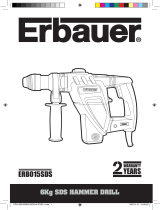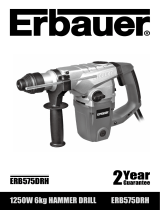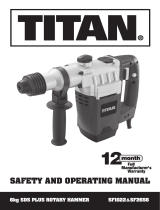Page is loading ...

2711
ROTARY HAMMER 32MM

USER MANUAL 1
PRODUCT SPECIFICATIONS
Model 2711
Power 1200W
Voltage 220-240V
Frequency 50-60Hz
No-load Speed 1050RPM
Impact Rate 4200BPM
Impact Energy 5J
Chuck Type SDS Plus
Max. Drilling Diameter
Concrete: 32mm
Steel: 13mm
Wood: 40mm
Weight 5Kg
Accessories
SDS PLUS 8×150mm Drill bit
SDS PLUS 10×150mm Drill bit
SDS PLUS 12×150mm Drill bit
14×250mm Point chisel
14×250mm Flat chisel
Depth Stop
Dust Cap
Grease Pot
Carbon Brushes
Side Handle

ROTARY HAMMER 32MM
2
PARTS LIST
SDS-Plus drill chuck
Tool holder
(SDS-Plus)
Dust
protection cap
Locking
sleeve
Locking
button
On/Off switch
Operational mode
selection switch
Auxiliary
handle
INTENDED USE
The machine is intended for hammer drilling in concrete, brick and
stone. It is likewise suitable for drilling without impact in wood, metal,
ceramic and plastic.
GENERAL SAFETY RULES
.WORK AREA
- Keep work area clean and well lit. Cluttered and dark areas invite
accidents.
- Do not operate power tools in explosive atmospheres, such as in
the presence of ammable liquids, gases or dust. Power tools create
sparks which may ignite the dust or fumes.
- Keep children and bystanders away while operating a power tool. Distractions
can cause you to lose control.

USER MANUAL 3
.ELECTRICAL SAFETY
- Power tool plugs must match the outlet. Never modify the plug in any
way. Do not use any adapter plugs with earthed (grounded) power tools.
Unmodied plugs and matching outlets will reduce risk of electric shock.
- Avoid body contact with earthed or grounded surfaces such as pipes,
radiators, ranges and refrigerators. There is an increased risk of electric
shock if your body is earthed or grounded.
- Do not expose power tools to rain or wet conditions. Water entering a
power tool will increase the risk of electric shock.
- Do not abuse the cord. Never use the cord for carrying, pulling or unplugging
the power tool. Keep cord away from heat, oil, sharp edges or moving parts.
Damaged or entangled cords increase the risk of electric shock.
- When operating a power tool outdoors, use an extension cord suitable
for outdoor use. Use of a cord suitable for outdoor use reduces the risk of
electric shock.
- If operating a power tools in a damp location is unavoidable, use
a residual current device (RCD) protected supply. Use of an RCD
reduces the risk of electric shock.
.PERSONAL SAFETY
- Stay alert, watch what you are doing and use common sense when
operating a power tool. Do not use a power tool while you are tired or under
the inuence of drugs, alcohol or medication. A moment of inattention while
operating power tools may result in serious personal injury.
- Use safety equipment. Always wear eye protection. Safety equipment
such as dust mask, non-skid safety shoes, hard hat, or hearing protection
used for appropriate conditions will reduce personal injuries.
- Avoid accidental starting. Ensure the switch is in the off position before
plugging in. Carrying power tools with your nger on the switch or plugging
in power tools that have the switch on invites accidents.
- Remove any adjusting key or wrench before turning the power tool on. A
wrench or a key left attached to a rotating part of the power tool may result
in personal injury.

ROTARY HAMMER 32MM
4
- Do not overreach. Keep proper footing and balance at all times. This enables
better control of the power tool in unexpected situations.
- Dress properly. Do not wear loose clothing or jewelry. Keep your hair,
clothing and gloves away from moving parts. Loose clothes, jewelry or long
hair can be caught in moving parts.
- If devices are provided for the connection of dust extraction and
collection facilities, ensure these are connected and properly used.
Use of these devices can reduce dust related hazards.
.POWER TOOL USE AND CARE
- Do not force the power tool. Use the correct power tool for your
application. The correct power tool will do the job better and safer at
the rate for which it was designed.
- Do not (use the power tool if the switch does not turn it on and off. Any
power tool that cannot be controlled with the switch is dangerous and
must be repaired.
- Disconnect the plug from the power source before making any
adjustments, changing accessories, or storing power tools. Such
preventive safety measures reduce the risk of starting the power
tool accidentally.
- Store idle power tools out of the reach of children and do not
allow persons unfamiliar with the power tool or these instructions
to operate the power tool. Power tools are dangerous in the hands
of untrained users.
- Maintain power tools. Check for misalignment or binding of moving parts,
breakage of parts and any other condition that may affect the power tools
operation. If damaged, have the power tool repaired before use. Many
accidents are caused by poorly maintained power tools.
- Keep cutting tools sharp and clean. Properly maintained cutting tools
with sharp cutting edges are less likely to bind and are easier to control;
- Use the power tool, accessories and tool bits etc., in accordance
with these instructions and in the manner intended for the particular
type of power tool, taking into account the working conditions and the

USER MANUAL 5
work to be performed. Use of the power tool for operations different
from intended could result in a hazardous situation.
.SERVICE
your power tool serviced by a qualied repair person using only identical
replacement parts. This will ensure that the safety of the power tool is
maintained.
SPECIAL WARNING FOR ELECTRIC HAMMER
- Wear ear protection. Exposure to noise can cause hearing loss.
- Use auxiliary handle with the tool. Loss of control can cause personal
injury.
.ADDITIONAL SAFETY INSTRUCTIONS FOR YOUR HAMMER DRILL
- Wear protective goggles.
- When working, sparks or ying splinters, shavings, and dust can cause
loss of vision
NOTE:
- Working safely with this machine possible only when the operating and
safety information are read completely and the instructions contained
therein are strictly followed.
- Before using for the rst time, ask for a practical demonstration.
- If the cable is damaged or cut through while working, do not touch the
cable but immediately pull the mains plug.
- Never use the machine with a damaged cable.
- Wear safety glasses, protective gloves and sturdy shoes.
- Wear ear protection to prevent damage to your hearing.
- The machine must not be damp and must not be operated in a wet
environment.
- Keep long hair away from the machine.
- Do not operate while wearing loose clothing.

ROTARY HAMMER 32MM
6
- Connect the mains plug only when the tool is switched off. After using,
pull the mains plug.
- Always direct the cable to the rear away from the machine.
- Do not carry the machine by the cable.
- When working with the machine, always hold it rmly with both hands
and provide for a secure stance.
- During pauses in the work, when not in use or during work on the
machine itself (e.g., changing of the working tools, repairs, cleaning,
adjustment), pull the mains plug.
- Persons under 16 year of age are not permitted to operate this machine.
- Keep the tool accessories out of the reach of children.
- Only use original accessories.
BEFORE USE
- Be careful of hidden electrical lines or gas and water pipes. Check the
working area, e.g. with a metal detector.
- Always use the correct supply voltage!
- The voltage of the power source must agree with the value given on the
nameplate of the machine. Machines designated for 220V.
TOOL CHANGING
NOTE:
Take care that the dust protection cap is not damaged when changing tools.
.SDS-PLUS TOOLS
The SDS-Plus tool is designed to be freely movable. This causes
eccentricity when the machine is offload. However, the drill
automatically centers itself during operation. This does not affect
drilling precision.

USER MANUAL 7
.INSERTING TOOL
- Clean lightly the tool before inserting.
- Pull the Locking sleeve backward
- Insert the tool into the tool holder and rotate it to engage.
- Release the Locking sleeve and make sure the tool is locked out by
pulling it out.
.REMOVING TOOL
- Pull the locking sleeve to the rear and hold while removing the tool.
- Do not use tools without SDS-plus for hammer drilling or chiseling.
OPERATION
.SWITCHING ON
Press the on- off switch
.SWITCHING OFF
Release the on- off switch
On/Off switch

ROTARY HAMMER 32MM
8
WORKING INSTRUCTIONS
.AUXILIARY HANDLE
You will be able to obtain a safe position when working by rotating
the handle attachment. Loosen and turn the handle attachment in an
anticlockwise direction. Then tighten the handle attachment.
.DEPTH STOP
Loosen auxiliary handle. Adjust the drilling depth on the depth stop.
Retighten the winged screw.
Tool holder
(SDS-Plus)
Auxiliary
handle
.OPERATING MODES
WARNING!
When switching operation modes, please trigger ON/OFF switch slightly.
1) Hammer Drilling

USER MANUAL 9
2) Drilling
3) Hammering
4) Chisel position adjustment
.SHARPENING THE CHISELING TOOLS
With sharpened insertion tools, one achieves good working performance
and long service life. Therefore, sharpen the chisel regularly.
Sharpen the tool on a grinding wheel (e.g. alumina oxide) with constant
water supply.

ROTARY HAMMER 32MM
10
MAINTENANCE AND CLEANING
NOTE:
Do not attempt to manipulate at any time during the warranty period and,
in the event of any inconvenience, ask for help from authorized RONIX
AFTER SALES SERVICE representatives.
- Before any work on the machine itself, pull the mains plug.
- For safe and proper working, always keep the machine and the ventilation
slots clean.
- Clean the tool mount daily.
.REPLACING THE DUST PROTECTION CAP
- Damaged dust protection caps should be replaced as possible since dust
that enters the tool holder can cause malfunctions.
- Pull back and hold the locking sleeve
- Pull off the dust cap with a suitable tool.
- With the locking sleeve pulled back, pull on the new dust cap until it sits
rmly over the tool holder and the locking sleeve can again be slid forward.
ENVIRONMENTAL PROTECTION
- Recycle raw materials instead of disposing as waste.
- Machine, accessories and packaging should be sorted for
environment-friendly recycling.
- These instructions are printed without chlorine.
- The plastic components are labeled for categorized recycling.
NOTE:
To maintain product SAFETY and RELIABILITY, repairs, any other
maintenance or adjustment should be performed by RONIX SERVICE
Authorized centers, always using RONIX replacement parts.


/



